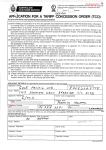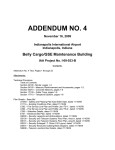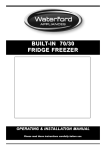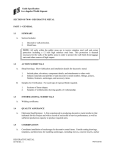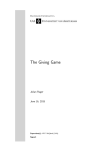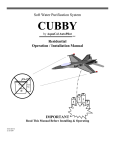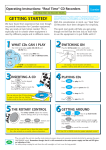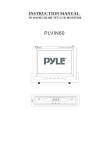Download Troubleshooting Guide
Transcript
Troubleshooting Guide 1. Cover blowing off the pool ................................Page 1 12. Seams in the blanket..........................................Page 3 2. Roller is blowing into the pool ..........................Page 1 13. Start of seam is open .........................................Page 3 3. Cover keeps moving to one side .....................Page 1 14. Blanket coming apart at the seams ................Page 3 4. Rips, tears and holes in the cover ...................Page 2 15. Salt build up on top of the pool cover .............Page 3 5. The pool is going green with the cover on .....Page 2 16. The pool cover has shrunk ...............................Page 4 6. De-lamination ......................................................Page 2 17. Shrinkage caused by overheating ...................Page 4 7. Water entering pool cover bubbles .................Page 2 18. The cover is wrinkly and doesn’t sit flat on the water.............................................Page 4 8. Water condensation in the bubbles.................Page 3 9. Bubbles have gone flat ......................................Page 3 10. Bubbles breaking up and falling off underside........................................................Page 3 11. Outer (top) surface of bubble peeling off........Page 3 1. Cover blowing off the pool For the cover to blow off the pool the wind needs to be able to get underneath it, causing it to lift up and blow across the pool. This may be happening for a number of reasons: i) The cover has not been cut to shape and you are attempting to keep it in place by using weighted objects. Solution – To work most effectively and not blow off the pool, it is essential the cover is cut to shape and installed correctly, please refer to Installation Instructions. ii) The cover has been cut to shape (allowing an upturn) but the upturn is too large and protruding above the top edge of the pool. Solution – Trim the cover carefully until the upturn is the correct 75 – 100mm and does not go above the pool edge (Coping). iii) The cover has moved on the pool, showing the water on one side and overhanging the pool on the other side. Solution – See Problem 3: Cover keeps moving to one side following. iv) There has been enough rain to significantly raise the pool water level resulting in the cover edge sitting above the coping of the pool. Solution – Reduce the amount of water in the pool with your wastewater facility or remove the blanket until the excess water has evaporated. 2. Roller is blowing into the pool The roller itself can’t normally be blown by the wind, but there can be reasons why it is being moved in windy conditions. i) The ropes have been installed too short. This is raising the end of the cover off the pool surface, enabling the wind to get under the pool cover, move it, and pull the roller (by the cords) into the pool. 1 Solution – install the correct length ropes (2 meters as supplied), and leave them that long so there is plenty of rope between roller and the cover laying 19. Fallen bubbles ......................................................Page 4 20. Blanket not rolling up straight/is difficult to roll up ..................................................Page 4 21. Pool cover is not warming the water ...............Page 4 flat on the pool. Any excess can be wound around the roller tube. ii) The roller’s overcover is being stored on the roller while the pool cover is on the pool. The wind can get under the overcover (like a sail on a yacht) and propel the roller into the pool. Solution – remove the overcover and store it elsewhere. This won’t happen with the pool cover stored on the roller and the overcover installed because of the combined weight of the cover and roller. iii) The cover is too large and protruding above the side of the pool. The cover is then lifted by the wind, still connected to the roller by the cords, and pulls the roller. Solution – see Problem 1: Cover Blowing Off The Pool above. 3. Cover keeps moving to one side i) This normally happens on a kidney-shaped or curved pool with an ‘inside curve’. When the cover is cut allowing an even 75-100mm upturn all around, the upturn on the ‘inside curve’ tends to push the cover away from that side and up over the opposite edge of the pool. Solution – carefully trim the blanket flat to the waterline on the ‘inside curve’ side or put some dressmaking tucks in the upturn along the ‘inside curve’ to alleviate the pressure. ii) The cover is being moved by water return jets angled up directing the water at the cover – or, jets set too high in the pool. Solution – if a jet is aimed up at the cover, loosen it and aim down, away from the blanket. If the jets are too high, you may be able to add more water to bring the water level above the return jets. If not, you need to contact your local pool shop about a redirection fitting to move the return water jets further under the water level. 4. Rips, tears and holes in the cover A small perforation in the plastic cover material is not a major problem. The damage is primarily cosmetic and the cover is just as effective and the warranted life span is not compromised. However, some water may seep through and collect on top of the cover. Solution – You can purchase self-adhesive patch material that will cover most small holes or tears when applied to the top of the cover. The patch is cosmetic (but is darker than the colour of the cover) and will stop water coming through the hole. 5. The pool is going green with the cover on A green pool indicates a high concentration of algae. Algae is a pest organism that is always present, to some extent, in your swimming pool. However, it can become resistant to normal levels of chlorine and breed rapidly if the conditions are right. The conditions that promote algae growth are: • low chlorine levels • warm water • a food source (phosphates). Simply fitting a solar pool cover will not make the pool go green. However, because solar covers will warm the water, they can accelerate algae growth. Solution – Change the pool conditions to prevent algae growth. It is important you consult with your pool shop as to the best method for your pool. A common method is to add algaecide or shock chlorinate the pool to kill the algae spores, filter the pool for longer to remove the algae, and use an algae starver to remove the phosphates from the water. Please Note – Remove Pool Cover for 48 hours after shock treating a pool. 6. De-lamination Daisy solar pool covers consist of two layers of material laminated together. The bottom layer has the moulded bubble shape and is heat-laminated during manufacture to a flat top layer. De-lamination refers to the two layers separating. This is very rare, but can occur in certain cases. i) Material de-lamination caused by faulty manufacture would mean the two layers of material separate completely. This is so rare that since commencement of current manufacturing techniques there has not been one recorded instance. ii) De-lamination caused by overheating. If the pool cover is left on the roller without the white UV overcover and exposed to full sunlight for even short periods of time – as little as 5 minutes when it’s very hot – overheating can occur. You will see evidence of this by the top of the bubbles becoming convex – or bulging out – rather than being flat. In severe cases this can cause pockets of de-lamination. These look like big bubbles, eventually showing a pattern running across the width of the cover, approximately every 600mm. The de-lamination will typically occur in “patches” at the end of the cover farthest from the roller when on the pool, and about 1-2 meters from the cover edge. In severe cases there will be de-lamination lines across the cover parallel to the roller. You will notice that when you wind the cover onto the roller that the de-lamination lines will line up on top of each other. This is because the sun’s rays hit the top of the roller and pass through the first few layers of pool cover. The pool cover magnifies the sun’s rays as they pass through – generating enough energy to superheat sections of the cover to a similar temperature to that used to laminate the layers during manufacture. The air inside the bubbles gets extremely hot and expands creating enough pressure to “pop” open the top and bottom layers. De-lamination caused by overheating is not covered under warranty. The solar pool cover will continue to work effectively to warm the pool and prevent evaporation – but you will experience some loss of useful life. When the pool cover eventually perishes, Daisy will cover the loss of lifespan under the warranty terms. Solution – de-lamination by overheating is totally preventable. Always ensure that as soon as you stow the pool cover on the roller, the protective UV overcover is fitted immediately. 7. Water entering pool cover bubbles Water can enter the bubbles is if the material is punctured by something – an object or rough pool surround. Water trapped in the bubbles may go green as the chemicals dissipate from the water. Water entering some torn or punctured bubbles will not affect the effectiveness or durability of the pool cover – see Problem 4 – Rips, tears and holes in the cover above. Solution – handle the pool cover with care and be wary of sharp objects or pool edges. You may need to move the roller right to the end of the pool – or over the water to avoid dragging the cover across rough surfaces or edges. If the pool has bullnosed coping, this effectively reduces the pool width at the top, so the sides of the cover may need to be trimmed a little shorter to accommodate the narrower space and make rolling off easier. 2 8. Water condensation in the bubbles The polyethylene plastic material used in the manufacture of Daisy solar pool covers is permeable to a degree. This means it will allow tiny quantities of liquids or gases to go through it. Some water vapour will permeate the material and enter the bubbles. As the temperature outside the bubble drops below ‘dew point’, the water vapour inside condenses, leaving a small quantity of water in the bubble. This condensation is perfectly normal and does not affect the cover’s performance or life span in any way. As soon as the temperature inside the bubble increases again, the water will evaporate. 9. Bubbles have gone flat This is a rare occurrence, and if it happens within the first twelve months of use, Daisy Pool Covers will replace the cover. If the cover is replaced, it is important you understand why it happened to prevent it occurring again. As chlorine reacts with other chemicals and organic material in your pool by-products called chloramines are created. One of these is a gas, Nitrogen trichloride. It is responsible for the strong chlorine smell around pools, particularly indoor pools. When Nitrogen trichloride builds up under the pool cover it can create a very high pressure. If there is a particularly low-pressure weather cell over the pool, the opposing pressures can create a powerful vacuum that forces the air out of the bubbles. Solution – before installing a Daisy solar pool cover, it is a good discipline to shock chlorinate the swimming pool to burn off residual chloramines and then allow chlorine levels to return to normal. Regular super chlorination or oxidation will avoid any future excessive chloramine build-up. Consult your local pool shop for advice. 10. Bubbles breaking up and falling off underside This degradation will only occur when the antioxidants present in the cover material have been used up. In short, the pool cover has worn out. The antioxidants help protect your pool cover from chlorine’s natural sanitisation process of oxidising everything in your pool. Oxidised plastic can be bleached white, become brittle and will break up when you touch it. If you have kept the recommended chlorine levels in your pool, then, this oxidised condition will mean that you have achieved the expected life span of the cover and it’s time to replace it. If the pool cover has not achieved its expected life, then it almost certainly has been subjected to excessive chlorine levels – either intermittently or consistently. 3 Solution –never place the pool cover on a pool with extremely high chlorine levels – for example, when super (shock) chlorinating. This will cause a severe immediate depletion of antioxidants from the cover material causing a significant increase in the oxidisation process and may damage the bubble wall. Monitor chlorine levels regularly and maintain them as recommended at all times. A pool cover that is consistently subjected to even slightly higher than recommended chlorine levels will have its useful life reduced due to an acceleration of the normal oxidisation process. 11. Outer (top) surface of bubble peeling off Ultraviolet energy from the sun will quickly break down most forms of plastic molecules. To counteract this, Daisy adds the maximum UV inhibitors to its pool cover material to prolong the life of the product. Due to harsh UV radiation and corrosive pool chemicals, all solar pool covers have a finite useful life, and some breakdown will naturally occur as the cover reaches the end of its expected lifespan. However, there is an important step which will help ensure the cover’s maximum expected life is reached. Solution – when the cover is not in use, always store it out of partial or direct sunlight. If a roller system is installed, fit the UV protective overcover as soon as the cover is rolled off the pool. 12. Seams in the blanket The base material Daisy uses to make its solar pool covers comes in a roll 200 metres long and 1.27 metres wide. The material width means that a Daisy pool cover is manufactured from a number of ‘panels’ of material welded together. For example, a Daisy cover for a 3.6 metre wide pool will consist of 3 ‘panels’ welded together. Daisy solar pool covers (and those from all other Australian suppliers) have always been manufactured this way – as it is simply not practical to produce the base material in greater widths. The welded seams are at least as strong as the material itself, and do not affect the cover’s performance or life span in any way. 13. Start of seam is open When a new pool cover is unrolled ready for installation, you may see that at one end of the pool blanket the start of the seam is not welded. This unavoidable ‘gap’ is where the welding machine has been started from. Solution – extra material has been added to the length of the blanket. You simply cut off this ‘unwelded’ area when trimming the blanket to fit the pool. 14. Blanket coming apart at the seams This is an extremely rare occurrence and would only normally happen due to a fault in the welding process during manufacture. Solution – Notify the company you purchased the pool cover from so Daisy can ascertain the age of the blanket and effect a replacement. 15. Salt build up on top of the pool cover If water from a salt pool is left on top of the pool cover, the water can evaporate leaving salt behind. This salt crust will not harm the blanket in any way, however, it is advisable to periodically wash any salt build continued next page up off as it can affect the cover’s solar heating performance by inhibiting the passage of solar energy through the cover. Solution – it is practically impossible to prevent any water getting on the top surface of the pool cover, however, try to pull the cover onto the pool with a bow motion to reduce the water that does get on top of it. 16. The pool cover has shrunk The manufacturing of solar pool cover material uses plastic extrusion under heat and pressure in specialised equipment. It is the nature of the process that some subsequent settlement of the material is to be expected. In our experience, up to 1% shrinkage can normally occur in the length of a pool cover (a 9.0 metre cover can shrink up to 90 mm). To allow for this, an extra minimum 300 mm is added to the length of the cover from the measured size of the pool to enable the installer to cut the cover to shape and allow an upturn of 50mm – 100mm average 75mm all around the pool. This is much more than adequate to compensate for the expected 1% maximum shrinkage in length. If a pool cover has shrunk more than 1% in length, or it has shrunk in width (shrinkage in width does not occur naturally), then the only possible explanation is that the blanket has experienced very significant overheating. 17. Shrinkage caused by overheating Overheating occurs when the cover is off the pool, folded or rolled up and left exposed to partial or direct sunlight. Over time, heat builds up within the layers of the folded or rolled-up cover, the plastic becomes more malleable, and the air inside the bubble expands. The expanding air stretches the bubbles and they take on a convex profile, rather than flat. This stretching of the bubble material over areas of the pool cover will abnormally shrink it. Such shrinkage is not covered under the warranty. The cover will continue to work effectively to warm the pool and prevent evaporation, however, you will experience some loss of useful life. When the pool cover eventually perishes, Daisy will cover the loss of lifespan under the warranty terms. Please Note – leaving a cover under shadecloth or a patio is not protecting the pool cover from the sun, you must store it in complete shade. 18. The cover is wrinkly and doesn’t sit flat on the water i) When the cover is rolled up and put into a box after manufacture there can be some folding lines or creases in the material. These will eventually disappear as the material has a memory and will always try to lay flat. If you have a roller, you can accelerate the process by leaving the cover rolled up on the roller with the overcover in place for a few days. ii) Minor manufacturing distortions in the base material can give it a slightly wrinkly look. This is not a fault, but an unavoidable consequence of the plastic extrusion process. When Daisy cuts and welds the material to form the finished pool cover, some heat distortion can accentuate this ‘wrinkliness’. The manufacture and welding processes makes this unavoidable and therefore, normal. It does not affect the pool cover’s performance or life span in any way. 19. Fallen bubbles A fallen bubble has had the top film of the bubble layer of material fall into the bubble-shaped lower film when in a semi-molten state during manufacture. These fallen bubbles are not uncommon in all types of ‘sealed air’ bubble products – including our pool covers. We accept a tolerance level of two fallen bubbles per square metre as within the manufacturer’s guidelines. A fallen bubble cell, whilst not cosmetically uniform to the rest of the cover, is not a weak spot (in fact as a double layer of film it is stronger), and it will not affect the warranty, life or performance of the pool cover in any way. 20. Blanket not rolling up straight/is difficult to roll up i) If the pool is kidney-shaped, an unusual shape or has a step area, there needs to be a clear “line of sight” from the roller edges down the pool cover before attempting to roll up. Ensure all step areas are folded over giving you this clear “line of sight” before rolling up. The shape of the pool may tend to push the cover one way, so you may need to pull the cover gently while rolling to keep it straight on the roller. ii) Ensure the roller position is perpendicular with the main body of the pool so the cover can come up evenly onto the roller. iii) Ensure the cords are pulling the cover evenly off the water and onto the roller. If not, adjust the cords so the cover is being pulled evenly. iv) Ensure the cover is being rolled onto the roller over the top of the tube, not underneath. iv) Ensure the roller is right at the end of the pool, or even extending over the water, before trying to roll in the cover. If the roller is back from the end of the pool (over the pool surrounds) it will make it hard to roll in the cover. Some pool shapes require the roller to be over the water by 1 meter or more to make it work correctly in rolling in the cover. 21. Pool cover is not warming the water Providing the bubbles are inflated and the blanket is in place, it warms the water and retains heat. It is as simple as that. In fact, short of covering the pool cover, you can’t stop it warming the water, and even then only partially. There is no way possible for the blanket not to warm the water. Only the environmental conditions – temperature and degree of sunshine/cloud – will limit the heat and are the only variable factors. 4






